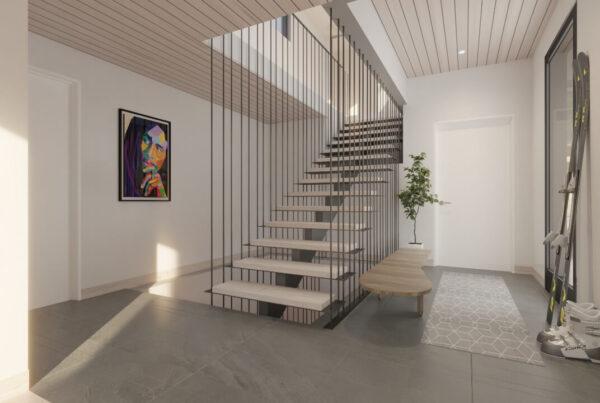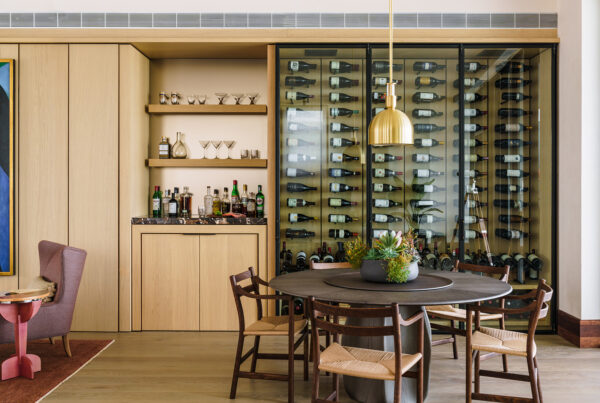What type of projects is Rubio Monocoat fine woodworking carpentry millwork builder best suited for?
Rubio Monocoat is a renowned brand in the world of woodworking, carpentry, and millwork, known for its excellent quality and durability. As a builder, when it comes to selecting the best-suited projects for Rubio Monocoat Fine Woodworking, there are a few factors that you need to consider.
Firstly, it’s important to understand that Rubio Monocoat is a premium finish that provides superior protection and enhances the natural beauty of wood. Therefore, it is ideally suited for high-end projects that require a unique and luxurious finish. Rubio Monocoat is best suited for projects that require a high level of attention to detail, and where the natural beauty and character of the wood are the focal points. While it might be expensive, a high traffic area like a table or millwork produced by a high-end woodworker demands it.
We love using Rubio Monocoat for interior projects, such as custom cabinets, furniture, and millwork. Be they walnut, and especially if you’re looking for a matte finish (over a satin), Rubio Monocoat is one of our go-to options. The finish gives a beautiful matte look to the wood and can be applied to a range of wood types from softwoods like pine to hardwoods like oak or maple. Rubio Monocoat can also be used on exotic woods, which are often used for high-end furniture and cabinetry.
Another area where we typically use Rubio Monocoat excels is in flooring projects. Rubio Monocoat produces a hard-wearing finish that can withstand high traffic areas without the need for excessive maintenance. The finish is also resistant to water and other liquids, making it ideal for use in bathrooms and kitchens.
Finer Points
Here are some additional tips for finishing a table with Rubio Monocoat:
Choose the right color: Rubio Monocoat comes in a range of colors, so choose the one that complements the wood species and grain pattern of your table. You can also mix colors to create a custom finish.
Apply the finish in a well-ventilated area: Rubio Monocoat has a strong odor, so make sure you work in a well-ventilated area or wear a respirator.
Use a foam brush or roller: A foam brush or roller helps to apply the finish evenly and prevents brush marks.
Buff the surface after 24 hours: After applying the finish, wait 24 hours before buffing the surface with a cotton terry towel or buffing pad. This helps to remove any excess oil and smooth out the finish.
Apply a second coat if necessary: If you notice any bare spots or uneven areas, you can apply a second coat of Rubio Monocoat to achieve a more uniform finish.
Remember, proper preparation and application are key to achieving a beautiful and long-lasting finish with Rubio Monocoat. So take your time, follow these tips, and enjoy your beautifully finished table!
The Truth, is it really that good?
When it comes to furniture finishes, there are a lot of options out there. Each has its own pros and cons, and it can be tough to determine which one is right for your project. But if you’re looking for a finish that offers the ease of use of boiled linseed oil and the protective properties of wipe-on poly, then you may want to consider Rubio Monocoat.
Rubio Monocoat is a hard wax finish that has been gaining popularity in recent years. It’s easy to apply, has zero VOCs, and looks like boiled linseed oil. But what sets it apart from other finishes is its protective properties. With Rubio Monocoat, you can get a matte or satin finish that’s both beautiful and durable.
One of the biggest benefits of Rubio Monocoat is ease of use. The three-to-one mixture is easy to apply, and there’s no need to worry about overcoating. Once applied, the finish dries quickly and is ready for immediate use. And because Rubio Monocoat has zero VOCs, it’s a great option for people working in small spaces. You don’t have to worry about fumes or ventilation, making it a much safer alternative to some other finishes.
Another benefit of Rubio Monocoat is its look. It looks like boiled linseed oil, with a beautiful natural finish. And it has a pleasant smell that’s much more enjoyable than the strong, astringent smell of some other finishes. And because Rubio Monocoat comes in a range of colors, you can find the perfect shade to match your project.
Of course, the biggest downside to Rubio Monocoat is the cost. It’s more expensive than other finishes, but for many people, the ease of use and protective properties make it worth the cost. And because it’s comparably expensive, it may not be the best option for large-scale projects.
Overall, Rubio Monocoat is a great option for anyone looking for a protective and durable finish that’s easy to apply and looks beautiful. It’s worth trying at least once, even if you’re skeptical of new finishes. It may just become your go-to for any furniture finish.
What type of colors and products is rubio monocoat fine woodworking carpentry millwork builder best suited for?
Rubio Monocoat is a premium brand of oil-based wood finishes. These finishes are popular among fine woodworking carpentry millwork builders for a number of reasons. Rubio Monocoat offers a wide range of products that are designed to meet the needs of different projects.
The company’s flagship product, the Rubio Monocoat Oil Plus 2C, is a two-component oil-based finish that provides excellent protection and durability for all types of wood surfaces. This finish is ideal for high-traffic areas such as floors, furniture, and countertops. Its unique molecular bonding technology ensures a uniform color results with just one coat, (sometimes some additional touch-up finish).
For those looking for a natural look, the Rubio Monocoat Pure offers a clear, matte finish that emphasizes the natural grain and color of the wood. This product is perfect for small woodworking projects such as cabinets, shelves, and decorative items.
If you want to add a touch of color to your project, the Rubio Monocoat Color line offers a range of pre-mixed colors that can be applied in a single layer. This product is perfect for creating a unique and customized look for your furniture, flooring, or other wood surfaces.
Rubio Monocoat also offers a range of maintenance products such as the Rubio Monocoat Universal Maintenance Oil, which provides excellent protection against water damage, scratches, and stains.
In summary, we love Rubio Monocoat fine woodworking carpentry millwork builders for projects that require a high-quality, durable finish on all types of wood.
Does Rubio Monocoat Hold Up Well?
Rubio Monocoat is a popular choice for finishing furniture, but does it hold up well? We put it to the test by using it on a heavily used walnut table for 18 months. The results were impressive.
The table was used daily for seven months and then used intermittently for the remainder of the 18 months. It was cleaned only with warm water, and no harsh chemicals were used. Despite heavy use, the table held up well. Glasses, beer bottles, and wine bottles were left on the table without causing any damage.
One incident did occur when a sharpie was used to mark the table. However, the finish was easy to repair by sanding down the table and reapplying Rubio Monocoat.
Overall, we found that Rubio Monocoat is an excellent finish for furniture. It holds up well, is easy to clean, and is easy to repair. If you’re looking for a durable and easy-to-maintain finish, Rubio Monocoat is a great choice.
To keep your Rubio Monocoat finish looking its best, we recommend cleaning it only with warm water and avoiding harsh chemicals. If damage does occur, the finish is easy to repair by sanding down the surface and reapplying the finish.
In conclusion, if you’re considering using Rubio Monocoat on your furniture, we highly recommend it. Our 18-month test proved that it is a durable and easy-to-maintain finish that will keep your furniture looking beautiful for years to come.
Hard wax vs polyurethane: Pros and Cons
Hard wax and polyurethane are two popular finishes for wooden furniture. Both protect the wood from damage and bring out its natural beauty, but which is better? We put them to the test on a walnut board to see how they held up against common damage and how easy they were to repair.
The board was first sanded to the recommended grit for each finish and then finished according to the instructions. The hard wax finish, specifically Osmo and Rubio Monocoat, had a closer-to-wood look and feel than the polyurethane, bringing out the character of the wood. However, the polyurethane had a slightly shinier finish and no film look, making it a good option for those who want a little more sheen.
The finishes were tested for durability against damage that everyday furniture faces. First, we tested them against condensation from a glass. The hard wax finish held up well, with just a ring visible after wiping off the excess water. The polyurethane had no visible damage. Next, we tested them against wax from a candle and a burn mark from a match. The hard wax finish had some melted wax and a burn mark that could not be buffed out, while the polyurethane had no visible damage.
Finally, we tested the finishes against everyday damage, such as nicks and scrapes from keys or other objects. The hard wax finish had deep gouges and scrapes, but no chipped finish because it is not a film finish. The polyurethane had no visible damage.
Overall, both finishes had their pros and cons. The hard wax finish had a closer-to-wood look and feel and held up well to water and wax, but had deep scrapes and gouges from everyday use. The polyurethane had a slightly shinier finish and no film look, making it a good option for those who want a little more sheen, and held up well to all tests.
In terms of repair, the hard wax finish was relatively easy to fix by sanding the affected area and applying more wax. The polyurethane, on the other hand, required more extensive sanding and applying multiple coats to match the original finish.
Ultimately, the choice between hard wax and polyurethane depends on personal preference and the intended use of the furniture. Hard wax is a good option for those who want a natural look and feel and do not mind some wear and tear, while polyurethane is a good option for those who want a little more sheen and durability. Regardless of the finish chosen, it is important to follow the instructions carefully and maintain the furniture properly to ensure it lasts for years to come.





